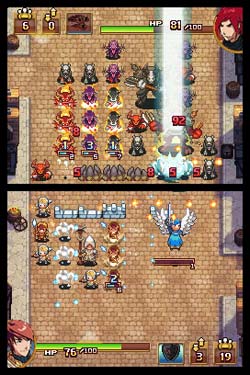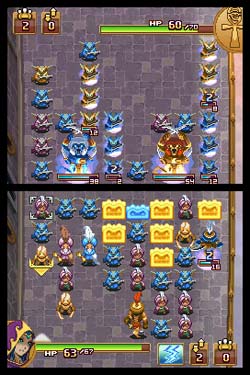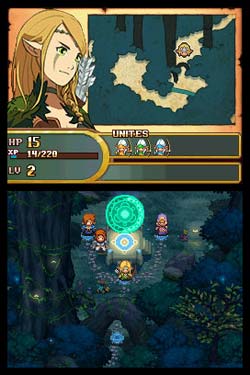
Despite the low profile release, and a name only someone with a shirt reading Dungeon Master could love, Capybara’s DS entry into the strategy genre stuffs more game up my stocking than I’d anticipated this season.
Sitting alongside recognizable brands on the store shelf, you’d be forgiven for going a tad cross-eyed reading the title Might & Magic: Clash of Heroes. The game is filled with the knights, elves, talking trees and evil hell spawn the title brings to mind. And while I don’t intend to undermine the effort but probably will anyway, such elements are just window dressing for a game more focused on proving Capybara an undisputed leader in creating addictive gaming experiences.
It’s not like I’d accuse Capy of having a shtick or suggest that the game repeats an established formula. But there’s definitely an emerging sense of familiar sensations attached to their work, and fortunately for us this is a good thing.
There is a campaign to give Clash of Heroes a more fitting name, the dominant choice being to refer to the game as one of the best DS titles you’ll likely miss in 2009. As much as I prefer to write my own music, it’s hard not to join the choir on that note. It only took one battle to verify that Clash of Heroes is a desert island game, offering a formula that I could endlessly gorge myself on – in short, a game that would make a hermit out of many if not for the included local multiplayer.

I have this recurring urge to compare the title to the best game people missed in 2008, Sega’s Valkyria Chronicles. That doesn’t mean to suggest that Clash of Heroes has the same level of sweeping dramatic tones or character design, though the game is not without its charms in that department. Beyond the fact that this is another sleeper hit waiting to be discovered, the real similarity is the way in which the strategy nature of the game causes me to stress and squirm in the same way Valkyria did last year. It’s a gut-wrenching affair having to end my turn and watch the enemy AI position units, locking in and questioning my decisions while waiting to see if my best laid plans will be ruined.
Explaining the situation may prove nearly as difficult as learning adaptive strategies, but let’s give it a go.
Clash of Heroes is laid out a bit like Connect Four, except you can’t score diagonally and the basic units only require you to connect three – still, I rather like the comparison. The lower DS screen displays your units on the battlefield, which are randomly dropped into rows that create columns across the screen and bring you face-to-face with the enemy deployment via the upper screen of the DS.

Each turn allots a few moves – never nearly as many as I need – in which to create offensive and defensive chains by linking three units of the same type in rows. Linking three in a vertical line creates an attack chain that moves those units to the edge in order to face the enemy, while connecting three or more in a horizontal line creates a barrier to absorb enemy attacks. Either move will push units still waiting for a chain toward the back for their chance to join the fight.
More powerful units are collected along the way, such as dragons and deer in the beginning. Each special unit has its own abilities and rules, for instance a deer requires two standard units of the same color and can jump enemy barriers, while a dragon requires four same colored units and spews poisonous acid.
Each attack takes a varying amount of turns, providing time to prepare as enemy attacks count down. Units that have completed an attack or have been destroyed are collected in a tab the player can tap with the stylus to redeploy them in a random order, though special units are lost if defeated and the player must purchase more while traveling the land.
Players can also remove standard units at anytime, and herein is where the game gets more interesting. Moving a unit from one column to another costs the player a move, but removing a unit that allows others to create a chain does not, with multiple chain occurrences giving the player an extra move within that turn. Layered over this is the ability to increase the strength of chained attacks by creating more of the same type.

This sets the stage for the element that keeps me coming back, because the way the game merges strategy with chance, with units starting at random positions and reinforcements falling into place anywhere they please taps into the charms of the puzzle genre. Clash of Heroes becomes a game as much about developing a strategy as it is about discovering accident advantages and potential bonuses provided by chance, giving us a game that requires a truly adaptive sense of strategy. The game even offers a special last-ditch attack based on the amount of damage dealt and taken, making several of my victories as much about pure luck as skill.
Being able to develop strategy as I go and having plans consistently change on-the-fly has kept the game reliably nestled in my DS. I’m continually surprised by how often an accident can play to my advantage, and sometimes I just outright reset the battle to see if I can get a better set of odds in my favor. There’s also a constant shake-up to keep battles evolving, at times asking the player to attack a specific unit or to defend one. When boss encounters offer up enemies that can move positions with little warning, the ability to adapt attack plans quickly becomes even more vital.

This all sounds a tad complicated, and there are additional elements continually introduced as the player progresses via an overhead map where the narrative unfolds and players move by tapping stones on the ground that form various paths – ensuring the stylus is the only tool needed to play the entire game. Additionally, players need to decide which special units to take into battle, and which special items to equip – standard perks such as the ability to rise from the dead for a second chance in battle or increasing the strength of certain units. Moving through the world of Might & Magic also offers various side-quests and challenges, my favorite proving to be the puzzle battles that offer scenarios asking players to work within a limited set of moves.
I could on for pages, but what seems most important to squeeze in here is the way in which everything fits the tiny screen of the DS so perfectly. The touchscreen is all players need to drop replacements, move units, build chains, and traverse the map, all without the myriad of management screens that normally bog a strategy title down.
There’s been no shortage of quality strategy titles where I simply forget how to manage it all if I leave it for too long. But everything here is so straightforward and streamlined that it’s easy to come back to it after any span of time so far. Beyond Capy’s knack for creating new addictions, the real magic at work is the creation of a game with deep layers of complexity and challenge that remains simplistic and inviting to both the player’s touch and comprehension.
Might & Magic: Clash of Heroes
Developer – Capybara Games
Publisher – Ubisoft
System – Nintendo DS
Release Date – December 1, 2009
*A copy of this title was provided by the publisher for review